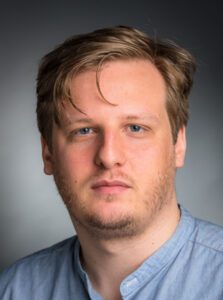Posted By: Kylee Spencer, PhD, Assistant Editor, AJHG
Each month, the editors of The American Journal of Human Genetics interview an author of a recently published paper. This month we check in with Sasha to discuss his recent paper “A comprehensive analysis of clinical and polygenic germline influences on somatic mutational burden.”

KS: What motivated you to start working on this project?
SG: Tumor Mutational Burden (TMB) is one of a few FDA approved biomarkers for immunotherapy in solid tumors but the mechanisms for why certain tumors are TMB-high and why certain TMB-high tumors still do not respond to treatment are poorly understood. Up to this point, most studies have focused on looking at other somatic features correlated with TMB or using small-scale data that’s several decades old. So, we wanted to explore the contribution of patient-level factors in a contemporary setting. We have a very unique cohort at Dana-Farber with a large number of sequenced tumors from which we’ve extracted both germline-level (patient) and somatic-level (tumor) variation that enabled us to take a deep dive into the correlates of TMB. It turns out that this relationship is quite complex! We identified a large number of factors that correlate with TMB, including some expected demographic features like age and sex but also some unexpected factors like genetic ancestry and germline predictors of complex traits. In some cases, these factors modify the predictive effect of TMB on patient survival after immunotherapy treatment.
KS: What about this paper/project most excites you?
SG: We’re very excited about the possibility of incorporating germline variation into the study of somatic features like TMB. One challenge with identifying causal factors in cancer is that many observed features are highly correlated with unobserved confounders such as the overall disease burden in the patient or their general health/frailty – confounders that we typically cannot measure accurately or at all. What’s unique with germline genetics is that it, by definition, predates these changes, and so if we see an association with a germline component, we can be more confident that there’s some kind of causal relationship that is driving it (of course we still need to be careful about confounding and false positives). In this work we focused on proof-of-principle examples like germline predictors of smoking and UV exposure, where there’s a fairly well-established causal connection to TMB. But we think this can be a broader platform for quantifying whether certain factors causally influence tumor evolution. And the power of this approach will continue to increase as we have more and more accurate germline predictors.
KS: Thinking about the bigger picture, what implications do you see from this work for the larger human genetics community?
SG: One thing we want to emphasize is that all of the data necessary to conduct such studies are already present in tumor sequencing results and can be extracted through imputation. So, our hope is that the community starts integrating important patient-level factors into their analyses.
KS: What advice do you have for trainees/young scientists?
SG: Don’t overthink it! Work on questions you are passionate about answering with people you admire and find pleasant to interact with.
KS: And for fun, tell us something about your life outside of the lab.
SG: My wife and I just had our third child (our first boy) so life outside of the lab has involved a lot of rocking, shushing, and bodily fluids 😊.
